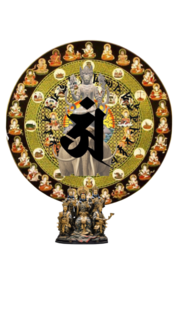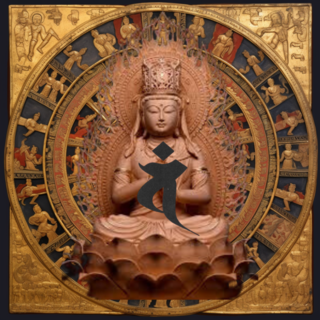���d�~�ς��ґz�@�z�@

�A���ނ��ґz�@���������B
�B
�V��n�́u���d�~�ρv�ł���B
����́A�����ɂׂ̂��V��q��́w�V�䏬�~�ρx�ꊪ�����Ƃɂ��Ă���ꂽ�����d�Ƃ����̂́A�傫�Ȉ̑�ȁh�Ƃ����Ӗ��B �~�́A�����ɂׂ̂��悤�ɁA �T���X�N���b�g��� Samatha �̖�ŁA�S�Âɂ������Ĉ�̑ΏۂɏW������ ���ƁB�ς́AVipaśyanā �̖�ŁA �~�ɂ���ē����������q�d�ɂ��A���̂��Ƃ������ώ@�������邱�Ƃł���B �v������ґz�̍��{�Z�@�ł���B �~�Ɗς����܂��� ��g���邱�Ƃɂ��A�_��I�Ȕ��E�]���̑̌���������̂ł���B
�ȉ��A�w�V�䏬�~�ρx�ꊪ�ɂ��ƂÂ��āA������悤�B
���̖{�́A�܂��ƂɖȖ��ɏ�����Ă��āA���Ƃ��A�~�ς��C���Ă���ΐg�S�� ���a���Č��N�ł���͂������A�Ƃ��ɁA�������ĕa������ (���a�Ȃǂ��\�ʂ� �o�Ă��邱�Ƃ�����B ���̎��ɂ́A����������Ȃ����Ȃ�������Ȃ��ƁA�~�� �ɂ�鎡�Ö@�܂łׂ̂Ă���B
�ґz���K�����߂ɂ͍ł��悢�w�����Ǝv����̂ŁA������Љ�悤�B �Ȃ��A ���{�͊����Ȃ̂ŁA���^�唎�m�̌����ɂ�������Ƃ������Ƃ�肵�Ă����B (�ς��C���邱�Ƃɂ���āA�������ĕa���������Ƃ�����A�Ƃ������Ƃɂ� ���āA����͔��ɏd��Ȃ��ƂȂ̂ŁA���Ƃł���ɂӂ�邱�Ƃɂ���)
�ґz�ɓ���O�̌܂̒��a�@
�܂��ܖ@����Ƃ���B
�ܖ@�Ƃ́A��Ɉ��H�߂��邱�ƁB ��ɐ����߂��邱�ƁB �O�ɂ͐g�� �����邱�ƁB�l�ɋC�����邱�ƁB �܂ɂ͐S���邱�Ƃł���B
���ɁA�H����Ƃ����̂͂��̂悤�Ȃ��Ƃł���B
�H���͂ق�炢���炾�����������������ɂ����܂��߂邽�߂̂��̂ł���B ����Ȃ̂ɁA�����H�ׂ����Ă���悤�ȏ�Ԃł���ƁA�C�͂�����A���炾�� ���邭�A�S���Ƃ��ꂪ���ŁA���T�����Ă��S�͈��炩�ɂȂ�ɂ����B
�����A�����H�ׂ邱�Ƃ����Ȃ����đ���Ȃ��ƁA���炾�͔��A�S�͕����A �v���Ƃ�����l���邱�Ƃ���������Ƃ��Ȃ��B ���̓�́A�ǂ�����T��� �铹�ɂ͂Ȃ�Ȃ��B
�������Ԃ�
�܂��A���������ꂽ���̂�悲�ꂽ���̂�H�ׂĂ���ƁA�ЂƂ̐S���� ���A�����₷������B �������炾�ɂ悭�Ȃ��h������H�ׂĂ���ƁA���˂Ă� �̕a�������Ă��邵 ���a���o�邱��)�A���炾�̒��q�������Ȃ�B������ �T����C�K���悤�Ƃ���Ȃ�A���̂͂��߂ɂ��ЂƂ��[�����������܂� ����Ȃ�Ȃ��B
���ɁA��������Ƃ����̂́A���Ƃ͂��ꖳ�����S�ɕ������Ԃ���̂� ���邩��A������ق����܂܂ɂ��Ă͂Ȃ�Ȃ��Ƃ������Ƃ��B
���邱�Ƃ��K�v�x���߂��đ����Ƃ��́A���ꂾ�����@���C�K���鎞�Ԃ� �p����邾���łȂ��A�w�͂̐S������ꂪ���ŁA�������S�����炭�����S ���v������B�܂��ɐl��������ł��邱�Ƃ����Ƃ�A�������悭�������āA�C���𐴔��ɁA�S�𖾂邭���悩�炵�߂邪�悢�B
��O�ɂ́A�g���A��l�ɂ͑����A��܂ɂ͐S����̂ł��邪�A ���̎O�̏����́A�܂��ɍ��킹�ėp���ׂ��Ȃ̂ŁA�ׂׂɐ������邱�� �͂ł��Ȃ��B�ȉ�����ɂ��ďq�ׂĂ݂悤�B
���ɐg����Ƃ́A����ꂪ�������ґz�����邽�߂ɂ́A���炾�� ���������Ȃ���Ȃ�Ȃ��Ƃ������Ƃł���B
�ґz���͂��߂�O����A�����Ƃ��ɂ������~�܂�Ƃ��ɂ��A�����Ƃ����Â� �ɂ��Ă���Ƃ����A�Ȃɂ������Ă���Ƃ��ł��A�����������݂Ȓ��Ӑ[���Ȗ� �łȂ�������Ȃ��B
�������삪�e�G�ł���A���Â��������ꂾ���݂����B ���Â��������炢
�ƁA�S���݂���Ă����߂ɂ����Ȃ�B ���T�����Ă݂Ă��A�S���݂��ꂪ���ŁA �����������C���ɂ͂Ȃ�ɂ����B
��������T���͂��߂�O����A���炩���ߒ��ӂ��Ă��Ȃ���Ȃ�Ȃ��B �̂悤�ɗp�S���Ă����āA�������T���͂��߂悤�Ƃ���Ƃ��ɂ́A�Ȃ��悭�g ���S������������悤�ȏ�������Ԃ悤�ɂ��Ȃ���Ȃ�Ȃ��B
�͂��߂č���ׂ��ꏊ�ɂ�����A���̏ꏊ�ɂ�������Ɨ��������Ȃ���� �����Ȃ��B�˂Ɉ����ɂ��Ă�����悤�ł���A���܂ł����܂������ �邱�Ƃ͂Ȃ��B
���ɂ͂܂��ɋr����p���𐳂������ׂ��ł���B
������������Ƃ�������肩���Ȃ�A���̋r���E�̋r�̏�ɂ����A�������������Đg�ɋ߂Â��A���r�̎w�ƉE�̂Ƃ����낦�A�E�r�̎w�ƍ��̂�������������Ƃ�������肩�������悤�Ƃ���Ȃ�A����ɉ��ɂ���E��
Makashikan's Meditation Imagination
describes two types of meditation.
.
It is a Tendai-style ``Makashikan''.
This is based on one volume of Tendai Chiho's "Tendai Kodigan", which was mentioned earlier, and means "meditation is great and great." Translated from the Sanskrit word Samatha, to keep one's mind calm and focused on one object.Vipaśyanā, translated from Vipaśyanā, means to observe and comprehend things correctly through the correct wisdom gained by stopping. It is a fundamental technique of meditation.By making full use of various stop and views, you can experience a mystical leap and transformation.
Below, I will explain based on the first volume of "Tendai Kodomekan".
This book is very meticulously written. For example, if you practice shikan, your body and mind should be in harmony and you should be healthy. At that time, it is said that this must be corrected as soon as possible, and even a treatment method based on the contemplation.
I would like to introduce this as it seems to be the best guidebook for learning meditation. Since the original is written in Chinese, I would like to point out that it was translated into colloquial by Dr. Shindai Sekiguchi. (As for the fact that by cultivating our views, we can actually move the sick, this is a very important point, and I will touch on it further later.)
Five Harmony Techniques Before Entering Meditation
It says to study the five laws first.
The five laws are the first to regulate eating and drinking. Second, regulate your sleep. Third, take care of yourself. Fourth, keep your breath. Fifth, prepare your mind.
First of all, preparing meals is as follows.
Food is really meant to help the body and keep it on the right path. And yet, if he is in a state of overeating, he becomes impatient, his body is sluggish, his mind tends to be restless, and it is difficult to calm his mind even when he sits in meditation.
But if you eat too little and not enough, your body will be tired, your mind will be dull, and you will not be able to think and think clearly. Neither of these two are paths to attain meditation.
Shigekibu
Also, if one eats something unclean or unclean, one's heart will be broken and it will be easy to get lost. If you eat irritants that are not good for your body, you will develop a long-standing disease (or chronic disease), and your body will get worse. Therefore, if one wishes to practice meditation, he must at the very beginning be a person who thoroughly understands these things.
Secondly, arranging sleep means that sleep is because ignorance overwhelms the mind, and he is not allowed to do so.
When you sleep more than you need, not only will you lose the time to practice Buddhism, but you will also tend to lose your spirit of effort, and your mind will become dull and sink. Realize that life is impermanent, get a good night's sleep, clear your mind, and make your mind bright and pure.
The third is to prepare the body, the fourth is to prepare the breath, and the fifth is to prepare the mind. Let's talk about this below.
Firstly, arranging the body means that in order for us to meditate properly, the body must be properly arranging.
Even before you begin to meditate, whether you walk or stand still, whether you are moving, whether you are still, whether you are doing something, you must be careful and thorough.
If the movements are sloppy, the breathing will be all the more disturbed. shortness of breath
And my heart is confused and it becomes difficult to calm down. Even if you try to sit in meditation, your mind tends to be confused and it is difficult to feel calm.
Therefore, even before starting zazen, you must be careful in advance. When it comes time to begin zazen, you should choose a place where you can calm down both physically and mentally.
When he first gets to where he should sit, he has to settle down firmly in that spot. If you can always remain calm, you will never be disturbed.
Next you should correct your posture right from the legs.
If you are sitting in a half-lotus position, place your left leg on top of your right leg, pull it close to your body, align your left toes with your right, and right toes with your left. If you want to sit in a tongs position, you can go further down to the right
�r�������グ�A��������̋r�̏�ɒu���B
���Ɉߑт��������߂�B
�������A���߂����āA�����Ă���Ƃ��ɒE���ė������肷�邱�Ƃ��Ȃ������ɂ��Ȃ�������Ȃ��B���Ɏ�𗎂�������B����̏����E��̏�ɒu ���A����������ˁA�������Ă���𗎂������A�Ƃ��ɍ��r�̏�ɒu���A �Ђ� ���Đg�ɋ߂Â��A�����ɓ��Ăė���������B
���ɐg�𐳂�������B
�܂��A���̂��炾�Ȃ�тɎ葫�⎈�߂���蓮�������ƁA���A���x���炢�� �邪�悢�B�܂��A�����ł��炾�𝆂݂ق����āA�葫�ɂ�������c���Ȃ��悤 �ɂ���B���ɂ͐g�𐳂�������B ����ɂ͑S�g��[���ɂ��A�w�����܂����� �ɂ��āA�Ȃ�������A����Ԃ����肷�邱�Ƃ̂Ȃ��悤�ɂ���B
���ɁA���𐳂�������B
�@�ƃw�\����������ɂ���悤�ɂ��A���ꂪ������炸�߂Ȃ炸�A ���� �����A�܂��A����Ԃ�Ȃ��悤�ɂ��A�������Z����B
���Ɍ����J���A�������q�ꂽ�C��f������B
�C��f�����@�́A�����J���A�C������A�v������Ԃ�ɂ����f���o���B ���̂Ƃ����炾�̂Ȃ��̂������̂�邢���̂����Ƃ��Ƃ������A���ꂪ�f���� �ɂ��������ďo�Ă䂭���̂Ɗϑz����B �o���������������A�@���琴�C ������B���̂悤�ɂ��ĎO�x�قǂ��肩�����B �g�������a����������A�� �x�����ł��悢�B
���Ɍ������B
�Ǝ����㉺���邭���R�ɍ��킹�A��͂���������悤�ɂ��ď�{�Ɍ��� ��B�����āA������B �킸���ɊO����f���x�ł悢�B���ꂪ�I������� �����p���𐳂������Đ�������)���邱�ƁA�̂��Ƃ��ł���B�g�� ���葫�����܂����������悤�Ȃ��Ƃ������Ă͂Ȃ�Ȃ��B
�ȏオ�͂��߂ɑT��ɓ���Ƃ��ɐg������@�ł���B �v�������Ă��� �A���Ȃ炸�}�Ȃ炴�邱�ƁB���ꂪ�g�̂̒��������ł���B
���T�ɍۂ��Ăǂ��ċz���邩
<�ċz�̎l�̑�
���ɁA�͂��߂č��T�ɓ���Ƃ��ɑ�������@�ɂ��ďq�ׂ悤�B
�ċz�ɂ͂��悻���̂悤�Ȏl��ނ̑�������B
��ɕ��A��ɁA�O�ɋC�A�l�ɑ��Ƃ����B
���̒��̑O�̎O��͒���Ȃ����ŁA��̈��A���������悭���������ł�
�Ƃ���ŕ��Ƃ�����̂́A���T�̂Ƃ��A�@�̂Ȃ��̑��ɏo���̉�������� ���A����ł���B
�R�̑��Ƃ́A���T�̂Ƃ��A�ċz�ɉ��͂��Ȃ�����ǂ��A���̏o���Ɍ����� ���āA�Ȃ߂炩�łȂ����Ƃ�[�Ƃ����B
�C�̑��Ƃ́A���T�̂Ƃ��A�����Ȃ��A�܂������Ȃ�����ǂ��A�o�����Ȃ� �炩�łȂ��̂��A�C�Ƃ����B
���̑��Ƃ����̂́A�����Ȃ��A�����Ȃ��A�e�����Ȃ��A�o�����ȁX�Ƃ� �āA�������Ă���̂����Ă��Ȃ��̂��킩��Ȃ��悤�ɂȂ�A�g���������Ĉ� ���ɁA�悢�C�����ɂȂ�B ���ꂪ���ł���B
���Ƃ������Ԃł���ƁA�C���U��B�R�Ƃ������Ԃ̌ċz���Â��� ����ƁA�S�ɂނ��ꂪ�ł��₷���B�C�Ƃ������Ԃ̌ċz���Â��Ă��� �ƁA�₪�Ĕ�ꂪ�ł�B���Ƃ������Ԃ̌ċz���Â��Ă���A �S������ �����āA�₪�Ē�܂��Ă���B
�܂�A���A�A�C�̎O��̑�������Ƃ��́A�����Ȃ��ċz�Ƃ����A ���T�ɂ����Ďv���̂��ƂƂȂ�B�S����܂�ɂ����̂ł���B
�ċz����O��̖@
�����������悤�Ƃ���Ȃ�A�܂��ɂ��̂悤�ȎO��̕��@�������� �݂邪�悢�B
���ɂ́A���_�����炾�̉��̂ق��ɗ��������A�����ɐ��_���W������B
���ɂ́A�g�̂��������Ă݂�B
��O�ɂ́A�C�����܂˂��S�g�̖эE����o�����Ă��āA��������܂������ �̂��Ȃ��Ɗϑz���邱�Ƃł���B
�������Ă��̐S��Â��ɂ��Ă���Α������X�R�ƂȂ�A���������A �v���� �����Ȃ����A���̐S����܂�₷���B���ꂪ����ꂪ�͂��߂ɍ��T������� ��������@�Ȃ̂ł���B �v�_�́A�a�Ȃ炸�A���Ȃ炸(�a�Ƃ͏a�� ���Ƃ͍s�������̂���)�Ƃ����̂��A���̒������l�q�ł���B
���̕��͂����ł́A���S�҂ɂ͂悭�킩��Ȃ���������Ȃ��B�t�ɂ��Ċw�ԕK �v�����낤�B
���ґz�ɂ����āA�ċz�͔��ɏd�v�ł���B �킽�����͍ł��d�v�ł���Ƃ��� �v���Ă���B �����ɂ�����Ƃׂ̂����A���Ɏߑ��́A���ʂȌċz�@�����܌o �łׂ̂Ă�����B �V��q��́A���ɒ����̈��܌o���y������Ƃ����߂��� ���������̂ŁA�����m��Ȃ������̂ł��낤�Ǝv����B�܂��ƂɎc�O�Ȃ�
�Ƃł���B���ɂ̌ċz�@�ɂ��ẮA���Ƃł��킵���ׂ̂�B
�S����ɂ͓�̕��@������
�͂��߂ɍ��T������Ƃ��ɐS����Ƃ������Ƃɂ́A���悻��̈Ӗ��� ����B
��ɂ́A�݂��ꂪ���ȐS���������āA�O�̗]���Ȃ��ƂɌ������ďo���� �肵�Ȃ��悤�ɂ��邱�ƁB��ɂ́A�܂��ɒ��E�E�E�}�قǂ悭���a���� �邱�Ƃł���B����ɂ��Đ������悤�B
���T�����Ă��āA�S�������Â��A�L�����͂����肹���A�����ǂ����Ă��Ⴍ ���ꂪ���ɂȂ邱�Ƃ�����B ����Ƃ����B���������Ƃ��́A���_��@�̓� �ɏW�����A�v�����˂Ɉ�̂��ƂɏW�����āA���U�����Ȃ��悤�ɂ���B�� �����Ȃ������@�ł���B
���Ƃ����̂́A���T�����Ă��ĐS���D��ł�ꓮ���A���炾���܂��������� �Ȃ��ŁA���ق��̂��Ƃ��l�����肵�Ă��܂����Ƃł���B���������Ƃ���
�́A�S�������Ɍ����ė��������A���_���w�\�ɏW�����A�݂��ꂪ���ȐS�𐧂� ��悤�ɂ���B�S����܂��ė��������A�S�͈��ÂɂȂ�B �v�_�������Ă��� �������A���Ȃ炸���Ȃ炸�A ����S���������l�q�ł���B
�₤�B�S�Ɋ��}�̑������邩�ǂ����B
�����B����͂���B��S���}�ł��鑊�Ƃ́A���T�̂Ƃ��ɍ��T�̒��ɐS�̂� ���炫�̑S�̂��W�߁A����ɂ���đT��ɓ��낤�Ƌ����w�͂��邱�ƂɌ����ċN����B ����䂦�ɁA�C������Ɍ����������ŁA�����}�ɒɂނ悤�Ȃ��� ������B����ȂƂ��ɂ́A��x���̐S���Ƃ���������ɁA�C�݂͂ȗ��ꉺ����z�����悢�B���ꂾ���Ŏv���͎��R�ɂ����܂�B
�ґz���A�ґz��̐S��
�S�����ł��鑊�Ƃ́A�S�u�����炯�A���炾���߂ɂ̂߂肱�ނ悤�ȋC�� ����������A���邢�͌����烈�_�������ꂽ��A����Ƃ��͐S���Â��Ȃ����� ����B���̂悤�ȂƂ��ɂ͂܂��Ɏp����������Ɛ����ĐS���Ђ����߁A�S���� �̂��̂��Ƃ̂Ȃ��ɏW�����A�g�̂������Ƃ���B ����łȂ���B �S�ɏa�� ���Ɗ��̑������邱�Ƃ��A����炩�炵�ėސ����Ēm����ł��낤�B �ȏオ
�͂��߂ɑT��ɓ���Ƃ��̐S������@�ł���B
�܂��A�ґz�̂Ȃ��ŁA�g�͒��a���Ă��Ă��A�ċz�����a���Ă��Ȃ����Ƃ��� �낤�B�s���̑��́A�����ɐ������悤�ɁA���邢�͕��A���邢�͉R�ł����� ��A���邢�͋C���}�̂��ߔw���ɒ�������悤�Ȃ��Ƃ�����A�������ɑO�� �@���������Ă�����Ȃ����ׂ��ŁA�˂ɑ���ȁX�Ƃ��Ă��邪���Ƃ��A�Ȃ� �����Ƃ��Ȃ炵�߂�B
�܂��A������ґz�̂Ȃ��ŁA�g�Ƒ��͒����Ă��Ă��A �S�����邢�͒��A���� ���͕��A���邢�͊��A���邢�͋}�ł��邱�Ƃ�����B ���̂Ƃ��ɂ́A�C���� �������A�O�̕��@��p���Đ����������Ȃ�������Ȃ��B
���T���͂��ł��A�g�E���E�S�̎O���ɒ���Ȃ����̂�����̂ɋC������ ��A�����ł����K���ɒ����āA����̂Ȃ��ł����g�E���E�S�̎O���� ���āA�������ނ��݂���邱�Ƃ̂Ȃ��悤�ɂ��邱�Ƃ��厖���B �����悭���a ���A�Ƃ������Ĉ�ɂȂ��Ă���A���˂Ă���̎v��������������A���� �W���͐����Ȃ����A�T��̓����킪���̂ƂȂ�B
���T����߂Ē���o�悤�Ƃ���Ƃ��̐g�E���E�S�̎O��������@�ɂ� �Č������B�������T���I����Ă܂��ɒ���o�悤�Ƃ���Ƃ��ɂ́A�܂����܂� �łЂ����߂Ă����S���Ƃ������ċC�������y�ɂ��A���Ɍ����J���ċC��� ���A�����S�g����ӂɂ��������ĊO�ɕz�U���Ă����Ǝv�����悢�B
�������Ă��炠�ƂŁA�����Ɛg�����A���Ɍ��E����ю�E�E ����Ȃǂ����A���ɗ��������āA �݂ȏ_�炩�Ȃ炵�߂�B ������ ���ꂩ���ɁA����ł��܂˂��S�g�̖эE�C����B
���ɏ��C���Ă��������Ȃ炵�߁A����������ė�����������A���̂� ���Ŋ���J���B�����Ă��炾�̔M���������~�ނ̂�҂��āA�����Ŏ����̕K �v�ɉ����ē������悢�B���������ɒ��ӂ��Ȃ��ƁA���T�͂�����x���܂��� �����Ƃ��Ă��A�������߂đT���o��Ƃ��ɂ����̒��ӂ������ƍׂ����v�f ���܂������ɂ��炾�̂Ȃ��Ɏc���Ă��āA���̒ɂ����Ƃ���������A���炾 �ߐ߂��ɂނ��ƁA���J(�C�̔��A�C�̕a��)�̂��Ƃ����Ƃ��������肷
��̂ł���B�g�͉��ŁA���͂��̒��Ԃɂ���A�S�͍ł��אÂȂ���̂ł���B �Ȃ���̂��āA�ׂȂ���̂ɏA���A�S�����ÂȂ炵�߂�B ���ꂪ�T��� ����Ƃ��̂͂��߂̐S���܂��ł���B
���T������Ƃ��ɁA��x�͂��łɐg���I����Ă��邪�A���T���ɁA�g�� ���A���邢�͋}�A���邢�͕A���邢�͋ȁA���邢�͒Ⴍ�A���邢�͗}������ ���Ă��邱�ƂɋC��������A�����ɐ����Ȃ�������Ȃ��B������������ �ŁA�Ȃ��Ɋ����Ȃ���}���Ȃ��A�����ɂ��Đ������Z�����߂�̂ł���B
Lift your leg up and place it over your left leg.
Next, untie the robe.
However, it should not be too loose and fall off while sitting. Then relax your hands. Place the palm of your left hand on top of your right hand.
Then straighten yourself out.
First, rock the body, limbs and joints, about seven or eight times. Also, massage your body by yourself so that you do not leave any lumps on your hands and feet. Next, straighten yourself out. To do this, keep the whole body straight and the spine straight, without bending or arching.
Then straighten your head.
The nose and the navel should be in a vertical line, and should not be slanted or slanted, nor should they be bowed or arched, and dwell right.
Next, open your mouth and exhale the filthy air in your chest.
The way to exhale is to open your mouth, release the energy, and let it out as much as you want. At that time, let go of all the bad things in your body, and visualize them coming out according to your exhaled breath. Close your mouth and let fresh air in through your nose. Repeat this three times. Only once is enough as long as the body and breath are in harmony.
Then close your mouth.
The teeth should be lightly aligned up and down, and the tongue should be lifted and directed toward the upper jaw. Then close your eyes. It is enough to cut off external light slightly. When that is over, correct your seiza posture and sit seiza), be like a stone. There should be no jerky movements of the body, neck, or limbs.
This is the way to prepare yourself when you first enter meditation. In short, he should be neither relaxed nor hasty. This is the toned phase of the body.
How to control your breathing during zazen
<Four phases of respiration
Next, let's talk about how to hold your breath when you first enter zazen.
There are roughly four phases of respiration.
The first is wind, the second is qi, and the fourth is breath.
Among these, the first three phases are not well-tuned, and the latter one, only the breath, is well-tuned.
By the way, what is called wind is the sound of breathing in and out of the nose during zazen.
The false phase is when there is no sound in breathing during zazen, but there is stagnation in the inflow and outflow of the breath, and it is called the edge.
Qi phase means that there is no sound or stagnation during zazen, but the movement in and out is not smooth.
The breath phase is that there is no voice, no stasis, no roughness, the comings and goings are smooth, and he becomes unsure if he is breathing or not, helps himself, is at peace, is good. I feel This is breath.
Being in a state called wind is distracting. If you continue to breathe in a state that is said to be a lie, it is easy for your mind to become connected. If you continue to breathe in the state called qi, you will eventually get tired. If you continue to breathe in the state called breath, your mind will become calm and settled.
In other words, when there are three phases of wind and qi, this is called unbalanced breathing, and it is the basis of thoughts in zazen. It is also difficult to settle the mind.
Three ways to adjust your breathing
If you want to find out about these things, just try the following three methods.
First, place the mind in the lower part of the body and concentrate it there.
Second, let your body relax.
The third is to contemplate that the mind is flowing in and out of every pore throughout the body, and that he has nothing to block it.
If you keep your mind quiet like this, your breath will be faint, and if your breath is fine, thoughts will not arise, and your mind will be easy to settle. This is how we catch our breath when we first sit in meditation. The main point is that it is not astringent and not slippery ("Shibu" means traffic congestion, and "Suri" means going too far).
This article alone may not be very clear to beginners. You will need to learn about your teacher.
Breathing is very important in note meditation. I even consider it the most important. As I mentioned a little earlier, the Buddha Shakyamuni speaks of a special way of breathing in the Agon Sutra. It seems that Tendai Chigi did not know this because he made the mistake of taking lightly the Agon Sutra directly taught by the Buddha. I am very sorry
and I will talk more about Buddha's breathing method later.
There are two ways to prepare your mind
He has roughly two meanings in preparing the mind when he first sits in meditation.
For one thing, he should try to keep his turbulent mind in check and not let him get carried away with extraneous things outside. The second is to be very calm... to harmonize as quickly as possible. Let me explain this.
When I meditate, my mind is gloomy, my memory is not clear, and my head tends to hang low. This is called shen. At such times, keep your mind focused on the tip of your nose, your mind always on one thing and not scattered. It is a method to fix this sinking.
Floating means that when you are sitting in meditation, your mind will sway and your body will not settle down, and you will inadvertently think about other things. at that time
Let him turn his mind downward, calm his mind, concentrate his mind on the navel, and control his turbulent mind. When the mind is settled and calm, the mind becomes quiet. To sum it up, it's not sinking, it's not floating.
ask. Whether there is an aspect of leniency in the mind.
answer. It is. The phase of quick concentration arises due to the fact that in sitting meditation the mind gathers in it all of its activities and thereby makes a strong effort to enter meditation. Therefore, the qi tends to move upward, and there are times when the chest suddenly hurts. In such a case, let go of that mind once and think that all qi will flow down. With that alone, your thoughts will subside naturally.
Mindfulness during and after meditation
A relaxed state of mind means that the mind is full of intentions, and the body feels like it is sinking in diagonally, or drools flow from the mouth, and sometimes the mind becomes dark. At times like these, you should straighten your posture, tighten your mind, focus your mind on one thing, and straighten your body. That's it. From these, it can be inferred that the mind has an astringent phase and a smooth phase. More than
It is a way to prepare the mind when entering meditation.
Also, in meditation, the body may be harmonious, but the breath may be out of harmony. As I said before, if you have a bad condition, or if it is a wind, or a lie, or if you are in a hurry and your back is full, you should immediately use the previous method to remedy it. So, he always breathes like he's still there, like he's gone.
Also, in troupe meditation, even if the body and breath are in harmony, the mind may be calm, floating, relaxed, or sudden. At that time, it is up to him to come to his senses and use the previous method to get it right.
During zazen, whenever you notice that there is something that is not in harmony with the three things of body, breath, and mind, you should adjust it accordingly, and always adjust the three things of body, breath, and mind in the troupe. , it's important not to get frustrated. If one is well harmonized and melted into one, even long-held thoughts will be removed, obstacles and hindrances will not arise, and the path of meditative meditation will become one's own.
Let's talk about how to prepare the three things of body, breath, and mind when you stop zazen and try to get out of meditation. When he is about to leave the sedation after zazen, he must first release his tense mind and relax, then open his mouth and let the air out, and the breath will flow out of his whole body according to his will. Think of it as spreading.
After that, move your body, then move your shoulders, hands, head and neck, then your legs, and soften them all. And he then rubs his hands all over the pores of his body.
Next, rub your palms together to warm them, cover your eyes with them, and open them with your hands. Then wait for the hot sweat of your body to cease a little, and then move according to your needs. If you don't pay attention to them, even if you can do zazen well to some extent, when you quit and leave zazen, if you don't pay attention to these details, the details will still remain in your body and you will have a headache. There are times when the joints of the body hurt, and there are things like wind labor (tiredness of mind, sickness of mind).
It is. My body is me, my breath is somewhere in between, and my mind is the quietest. Prepare what is, take care of what is small, and calm your mind. This is the initial mindset when entering meditation.
When you do zazen, you have already prepared yourself once, but during zazen, if you notice that your body is relaxed, steep, biased, curved, low, or restrained, , must be corrected immediately. There is always peace and tranquility, neither leisure nor urgency.
�y���̃J�e�S���[�̍ŐV�L���z
-
no image
-
no image






